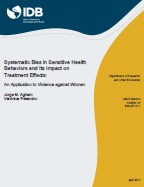Systematic Bias in Sensitive Health Behaviors and Its Impact on Treatment Effects: An Application to Violence against Women
Date
Apr 2017
Violence against women takes place mainly in the private sphere and isperpetrated by people close to the victim. These features can introduce large
biases into its reporting in specialized surveys as well as to the authorities. We
test for the existence of measurement error in the reporting of such violence using experimental methods in Peru, a country with several specialized surveys but one lacking reliable administrative data. We ask women to report past experiences of violent acts by randomly assigning them one of two questionnaires, one that replicates current surveys and another that relies on list experiments to provide a more private setting. We find no significant reporting bias on average. However, we uncover strong evidence of non-random measurement error by education level. For highly educated women, an increase in privacy leads to higher reporting of violence, while no change is observed for the less educated. The increase is large enough to reverse the education gradient in violence. We discuss how nonclassical error in the outcome variable affects the estimation of the role of risk factors on violence. In particular, randomized controlled trials underperform instrumental variables estimates and, under certain conditions, the former could lead to even larger biases compared to cross-sectional studies.
biases into its reporting in specialized surveys as well as to the authorities. We
test for the existence of measurement error in the reporting of such violence using experimental methods in Peru, a country with several specialized surveys but one lacking reliable administrative data. We ask women to report past experiences of violent acts by randomly assigning them one of two questionnaires, one that replicates current surveys and another that relies on list experiments to provide a more private setting. We find no significant reporting bias on average. However, we uncover strong evidence of non-random measurement error by education level. For highly educated women, an increase in privacy leads to higher reporting of violence, while no change is observed for the less educated. The increase is large enough to reverse the education gradient in violence. We discuss how nonclassical error in the outcome variable affects the estimation of the role of risk factors on violence. In particular, randomized controlled trials underperform instrumental variables estimates and, under certain conditions, the former could lead to even larger biases compared to cross-sectional studies.



